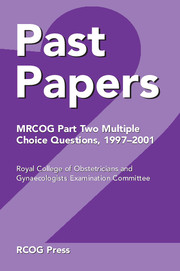March 1997
Published online by Cambridge University Press: 05 July 2014
Summary
Achondroplasia
1. is the most common lethal chondrodysplasia.
2. can be excluded by a normal fetal femur length measured by ultrasound at 18 weeks of pregnancy.
3. is associated with polyhydramnios.
4. is not associated with mental retardation.
Phenytoin
5. is best administered by intramuscular injection.
6. has a short biological half-life.
7. is rapidly absorbed from the intestinal tract.
8. is metabolised by the liver.
Neonatal jaundice appearing on the third day and still present at two weeks of age may be due to
9. haemolytic disease of the newborn due to rhesus incompatibility.
10. galactosaemia.
11. phenylketonuria.
12. neonatal hyperthyroidism.
Analysis of a sample of amniotic fluid obtained by amniocentesis assists in the diagnosis of
13. Tay-Sachs disease.
14. congenital adrenal hyperplasia.
15. spina bifida occulta.
16. oesophageal atresia.
The following diseases are inherited as autosomal recessive traits:
17. pseudohypertrophic (Duchenne) muscular dystrophy.
18. cystic fibrosis.
19. haemophilia.
20. phenylketonuria.
21. congenital spherocytosis.
Factors predisposing to maternal pulmonary aspiration of gastric contents during labour include
22. an increase in gastric motility.
23. the effect of progesterone on the cardiac sphincter.
24. epidural analgesia.
25. the use of muscle relaxant
Intrahepatic cholestasis in pregnancy is characteristically associated with
26. elevated serum concentrations of the direct bilirubin fraction.
27. a positive direct Coombs test in the neonate.
28. elevated serum acid phosphatase activity.
The following statements concerning preterm labour are correct:
29. Maternal administration of steroids is contraindicated in cases with prolonged rupture of membranes.
30. Women with a history of subfertility have an increased risk.
31. Babies weighing between 500–1000g should be delivered by caesarean section.
Information
- Type
- Chapter
- Information
- Past Papers MRCOG Part Two Multiple Choice Questions1997–2001, pp. 1 - 15Publisher: Cambridge University PressPrint publication year: 2004
